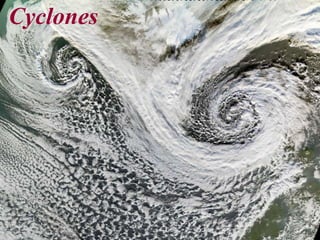
Natural Disasters Topic 10 (Cyclones)
- 1. Cyclones
- 2. Cyclones Cyclones are centers of low atmospheric pressure characterized by inward rotating winds. Tropical Cyclone Hamish (Australia), 2009 In North America, types of cyclones include tropical depressions, tropical storms, and hurricanes.
- 3. Cyclones & the Coriolis Effect Because of the Coriolis Effect, Northern Hemisphere storms track clockwise with counterclockwise surface winds that converge inward and clockwise high altitude winds that diverge outward. Those in the Southern Hemisphere have the opposite relationship.
- 5. Cyclone Structure (precipitation) http://www.srh.noaa.gov http://trmm.gsfc.nasa.gov Rising air leads to the formation of rainbands (spiraled arms) that decrease in magnitude outward.
- 6. “The Eye of the Storm” The eye of the cyclone is an area of high pressure at the center of the storm. It is characterized by clear, calm skies.
- 7. Tropical Cyclone Formation 1. A low-pressure system develops as air rises over warm ocean water (at least 800 F to depths of 150 ft with no vertical wind shear). 2. Because of the Coriolis Effect, air begins to spiral toward the center of the low-pressure cell, increasing in velocity as it approaches the eye-wall. 3. The incoming air rises and condenses as it loses heat, creating an area of high pressure at the center, which becomes the “eye” of the storm. 4. The storm continues to grow as it moves across warm ocean surface water. 5. Upon landfall or passing over cold water, the cycle breaks, and the storm begins to wane.
- 8. Stages of Development • Tropical Disturbance:Winds weak and unorganized • Tropical Depression:Winds less than 39 mph • Tropical Storm:Winds 39 to 74 mph • Cyclone:Winds greater than 74 mph
- 9. Hurricane Bill, 2009 Hurricane Dean, 2007 Cyclone Paths Because of the Coriolis Effect, most cyclones track clockwise in the Northern Hemisphere and counterclockwise in the southern, though the amount of deflection can vary. A few have relatively straight paths.
- 10. Types of Cyclones Cyclones have regional names, such as hurricane and typhoon, conforming to local traditions.
- 11. Hurricanes Hurricanes are cyclones that originate in the south Atlantic Ocean, moving to the northwest toward the Gulf Coast. Hurricanes have wind speeds of at least 75 mpg and can approach 200 mpg. They are named for Hurican, the evil Caribbean god of winds and destruction.
- 13. Typhoons Typhoons are the same as hurricanes but occur in the northern Pacific Ocean. They come from Chinese for “scary wind” or “wind from four directions.”
- 14. The Saffir-Simpson Scale Scale Number 1 2 3 4 5 central pressure (mb) > 980 965–979 945–964 920–944 < 920 wind speed (mi/hr) 74–95 96–110 111–130 131–155 > 155 storm surge (ft) 4–5 6–8 9–12 13–18 > 18 damage minimal moderate extensive extreme catastrophic http://eob.gsfc.nasa.gov Cyclones are classified on the basis of wind speed, as defined by the Saffir-Simpson Scale.
- 15. • Largest recorded hurricane: Typhoon Tip, Northwest Pacific, 12 October 1979 • Smallest recorded hurricane: Tropical Cyclone Tracy, near Australia, 24 December 1974 Remember that storms are classified on the basis of wind speed, not size. http://www.srh.noaa.gov Storm Size
- 16. Cyclone Frequency (annual) Tropical cyclones rely on dissipation of rising heat as an energy source; therefore, they are most frequent during time of the year when ocean surface water is warm.
- 17. Cyclone Frequency (long-term) Since 1851, when we began keeping records, cyclone frequency appears to be cyclical, most likely tied to solar energy output.
- 18. Effects The major effects of cyclones include high winds, heavy rains, storm surges, and tornadoes.
- 19. Wind Damage Wind speeds range from 75 to close to 200 mph, causing a tremendous amount of damage.
- 20. Tornadoes Tornadoes are commonly associated with cyclonic storms, particularly along the leading edge.
- 21. Storm Surges (Graphic by Robert Simmon, NASA GSFC) As a cyclone approaches land, sea-level rises (storm tide) due to low pressure conditions. This combines with wind-driven surface waves to produce high, surging waves along the coastline. The surge is greatest along the “front right” margin.
- 22. Hurricane Eloise, 1975, Florida Panhandle
- 25. Surge Damage Storm surges are the greatest cause of damage and death associated with cyclonic storms.
- 26. Inland Flooding Near the eye-wall, precipitation rates can exceed 10 in/hr, leading to severe flooding, including far inland from coastal regions.
- 27. Nor-easters http://www.weatherworks.com Nor-easters are extratropical cyclones that form in the North Atlantic during cold weather when the jet stream drops southward bringing arctic air into contact with warmer air masses. Such storms are characterized over land by large snowstorms and blizzards. Wind speeds can approach those of small hurricanes.
